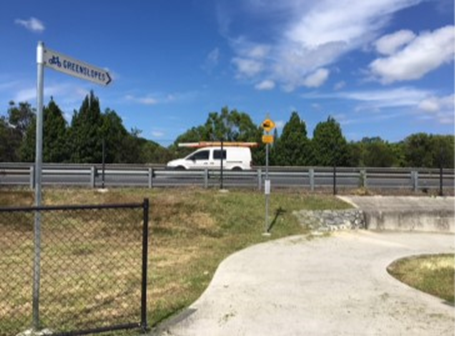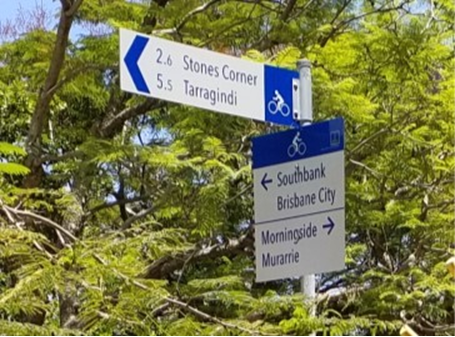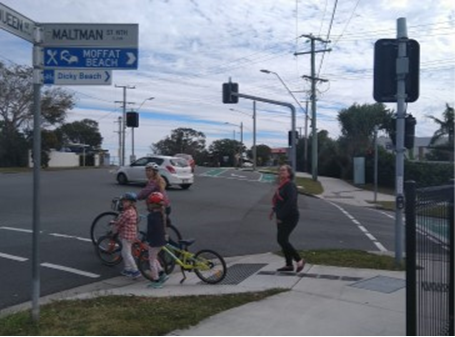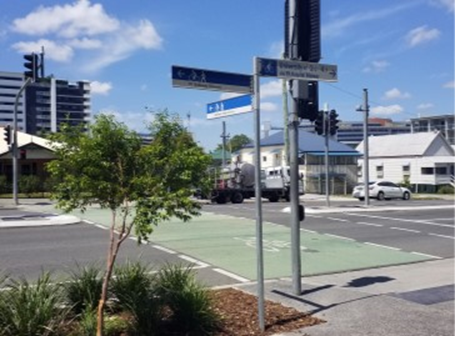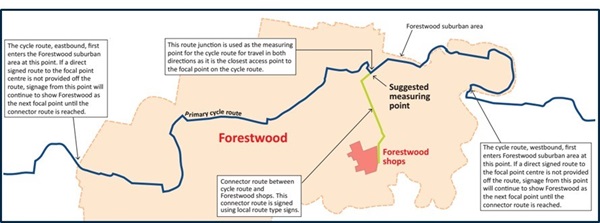Bicycle network signage and wayfinding guidelines
Wayfinding signage alerts people to the presence of cycling facilities and ensures they can navigate these facilities once they are on them. It is an essential component of bicycle networks.
The Queensland Government is committed to achieving the Queensland Cycling Strategy 2017-2027 vision of ‘more cycling, more often’, a key priority of which is building and connecting infrastructure to grow participation.
The following guidance supports practitioners to provide high-quality and consistent wayfinding signage for bicycle networks. This will help the growing number of Queenslanders riding make full use of the cycling infrastructure available.
On this page:
- Bicycle network signage benefits
- Process for signing bicycle networks
- Sign types
- Signage information and presentation
Bicycle network signage benefits
Process for signing bicycle networks
Consider installing wayfinding signage on existing facilities, new facilities and where it may direct people riding to preferred routes, between or without facilities.
A standard process is applied for developing and implementing directional signage schemes for cycling facilities. This ensures that users are given simple and consistent signage, that can be interpreted quickly and easily. There are 9 stages of signage planning, each with key guidance documents:
Resources
- See Queensland Principal Cycle Network Plans.
- See local governments for local bicycle network plans.
- See Austroads, AP-R492-15, Section B.4.1. for definitions of networks for signage.
The first task in signing a cycle route is to create a focal point map for the network. The map identifies destinations and decision points and coordinates signing across multiple routes. If destinations are not obvious, engage with stakeholders to identify the important destinations.
The only places listed on directional signs are focal points, terminal focal points, city/town centres and destinations shown on the focal point maps.
On routes from large metropolitan areas to a city centre, the destination ‘City’, ‘CBD’ or ‘Town Centre’, should continually feature in signage along the route.
Resources
- See local governments for focal point maps. If not available contact tmr.cycle.grants@tmr.qld.gov.au.
- For other routes Austroads, AP-R492-15, Section B.4.2 describes the process of developing focal point maps.
Resources
- See Austroads Research Report, AP-R492-15, Section B.3 for cycle route and sign types.
- See Principal Cycle Network Plans for principal routes and tourist routes. Local routes may be identified in local bicycle network plans.
Resources
- See Austroads Research Report, AP-R492-15, Section B.4.6 for a sample report structure.
- See Austroads Guide to Road Design Part 6A, Appendix D: Bicycle Safety Audit Checklist.
Resources
- Austroads Research Report, AP-R492-15, Section B.4.7 provides sample layouts for junctions on different routes.
This sign schedule should include:
- a list of all signs to be installed, removed or maintained.
- route maps, location maps and photos with installation guidance.
To ensure that the signs are installed correctly, provide precise and specific details regarding sign content, location and placement.
Resources
Maps should show precise locations of each sign, and diagrams/photos with installation guidance.
- See Austroads Research Report, AP-R492-15, Section B.4.8 for the process and sample schedule.
- See sections B.5-B.6 for sign locations and mounting.
- See Austroads Research Report, AP-R492-15, Appendix B, Section B.6 for installation guidance.
Provide maps, aerial photos, photographs and standard sign offsets from facilities to the installation team.
Resources
- See Austroads Research Report, AP-R492-15, Appendix A for basic layouts and elements of route signs.
- See Austroads Research Report, AP-R492-15, Appendix C, for symbol and letter dimensions.
The signage scheme designer or planner should undertake a final inspection to confirm all signs are installed, correctly labelled, facing the right direction and directional arrows are correct.
Any installation errors identified should be addressed at this stage.
- See Austroads Research Report, AP-R492-15, Section B.6.6 for post-installation review guidance
Sign types
The signs used on a route will depend on whether it is a veloway, principal, local or recreation route. Signs for veloways and principal routes may only be used on these routes.
However, local route signs may also be used on higher order routes where there is a junction with a local route. See Austroads Research Report, AP-R492, Section B.3 for signs.
Signs for veloways and principal routes
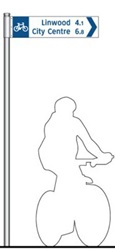
Fingerboard (FBP)
- Use these at route junctions and where the path changes direction.
- Place these signs at route junctions.
- These signs can fit up to 2 focal points.
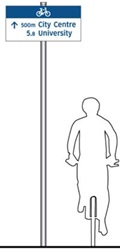
Direction Indication sign (DIP)
- Use these signs instead of fingerboards if fingerboards are not suited to the site.
- Place these signs at route junctions.
- These signs can fit up to 2 focal points.

Advance Direction Sign (ADP)
- Use these signs to show focal points on routes passing through a junction.
- These signs can fit 2 focal points.
- Place these signs at the approach to a junction.
- For veloways, 50–70m.
- For primary routes, 35–50m.

Reassurance Direction Sign (RDP)
- Use these signs following complex junctions to reassure cyclists they are on the right route.
- Place these signs on the departure side of more complex intersections.
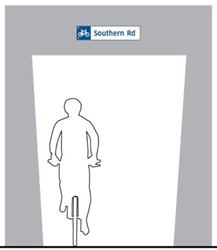 Location sign (LSP)
Location sign (LSP)
- Use these signs where paths track under or over the road network.
- Place these signs on underpasses or bridges.

Map sign (MSP)
- These signs provide additional assistance and often indicate multiple route options and wayfinding possibilities.
- Use these signs at significant junctions of multiple routes and key entry points to the network.
- Place these signs 1.5m from the path or road at a safe, well-lit area with set-down space for bikes.
Signs for local routes
Use these signs on local routes, or:
- veloways
- primary routes
- recreational routes
- at junctions with local routes.
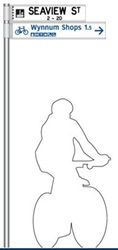
Fingerboard mounted with street name sign (FBL)
- These signs provide additional assistance and often indicate multiple route options and wayfinding possibilities.
- Use these signs at significant junctions of multiple routes and key entry points to the network.
- Place these signs 1.5m from the path or road at a safe, well-lit area with set-down space for bikes.

Local route marker—horizontal layout (RML-H)
- These signs provide reassurance to users between fingerboards, where a horizontal arrow facing users shows route direction.
- Use these signs where the route turns or changes between on-road and off-road.

Local route marker—vertical layout (RML-V)
- These signs provide reassurance to users between fingerboards, where a vertical arrow facing users shows route direction.
- Use these signs where the route transitions between on-road and off-road or on straight sections where reassurance may be required.
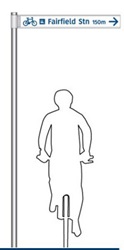
Facilities/services indication sign
- These signs indicate facilities such as water points, stations, information services.
- Use these signs at junctions of local and principal/veloway routes or in parklands and recreational areas.
Tourist and recreational routes
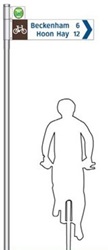
Fingerboard with external route branding (FBT)
- These signs are used to sign a single tourist/recreational route.
- Use these signs at route junctions and where path changes direction.
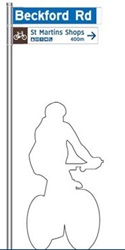
Tourist facilities fingerboard with local street sign (FIT-1)
- These signs are used to sign facilities and points of interest including attractions, amenities, accommodation and tourist services.
- Use these signs at junctions where users can access facilities or locations with facilities.

Tourist/recreational route marker horizontal layout (RMT-H)
- These signs provide reassurance to users between fingerboards, where a horizontal arrow facing users shows route direction.
- Use these signs where the route turns or changes between on-road and off-road.

Tourist/recreational route maker with vertical layout (RMT-V)
- These signs provide reassurance to users between fingerboards, where a vertical arrow facing users shows route direction.
- Use these signs where the route transitions between on-road and off-road or on straight sections where reassurance may be required.

On-road training route marker (RMTR)
- These signs are placed on specially identified fitness and training routes for on-road cyclists.
- Use these signs along the route.
Signage information and presentation
Focal points
Focal points are used to plan cycle route signage and are listed on signs within the bicycle network. A focal point is a destination where routes join, cross or end.
Follow these guidelines when listing focal points on signs:
- Maintain rigid consistency in naming locations.
- Street name signs should be in place at all network junctions, as they help riders reach their destination as quickly as possible.
- Once a focal point is listed on a sign, it continues to be listed on each similar sign along that route until the destination focal point is reached.
- Focal points closest to the sign are always listed to the top of the sign.
- When a destination focal point is reached, the next destination focal point is listed in its place on subsequent signs.
- Only focal points that occur on a route are listed on signs along that route. Advance direction signs are an exception to this rule, as they show focal points for all routes passing through the junction.
- Focal points take precedence over sub-destinations where space is limited on signs. Sub-destinations are used on longer routes with intermediate centres which are important ‘markers’ for people riding.
CBD and suburban focal points
For large metropolitan CBDs where routes do not intersect at a single junction, the city centre focal point is usually defined as a small area encompassing all route junctions.
If the focal point is a suburb without a strong centre or, if the cycle routes skirt around the service centre, it can be difficult to determine the location of the focal point.
There are 2 key issues to consider:
- When is the focal point reached?
If a route does not pass through the town centre of a suburb, the measurement point is usually the closest junction providing local route access to the centre or a logical destination point established through consultation with stakeholders. The focal point is measured to this junction.
- How is the signage scheme continued to a destination within a focal point suburb?
Where the focal point is not immediately obvious (for example a suburban junction), it is recommended that the signage scheme is continued to a more specific destination within that suburb by signing a local cycle route. In the example below, the principal cycle route identifies “Forestwood” as a focal point. Local route signage is then provided from the principal route to the “Forestwood shops”, along a cycle route on local streets.
Where to go for help about directional signage for wayfinding in Queensland
If you have questions relating to directional signage for wayfinding in Queensland, you can contact tmr.cycle.grants@tmr.qld.gov.au.
- Last updated 16 February 2023


